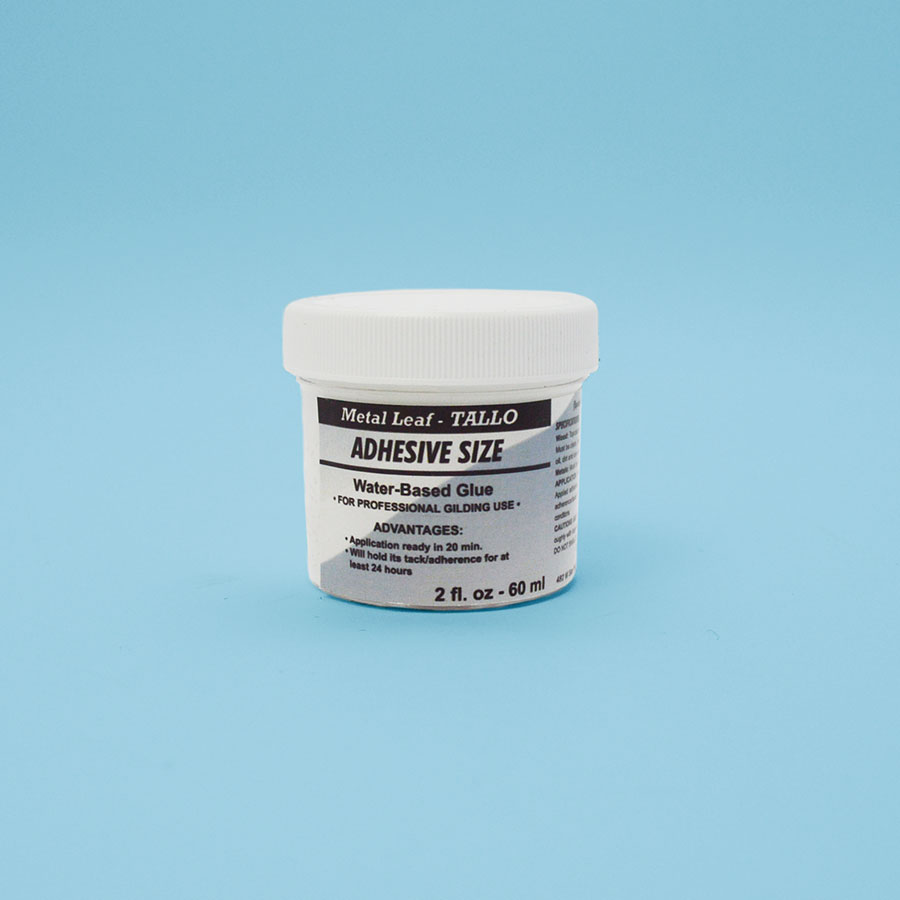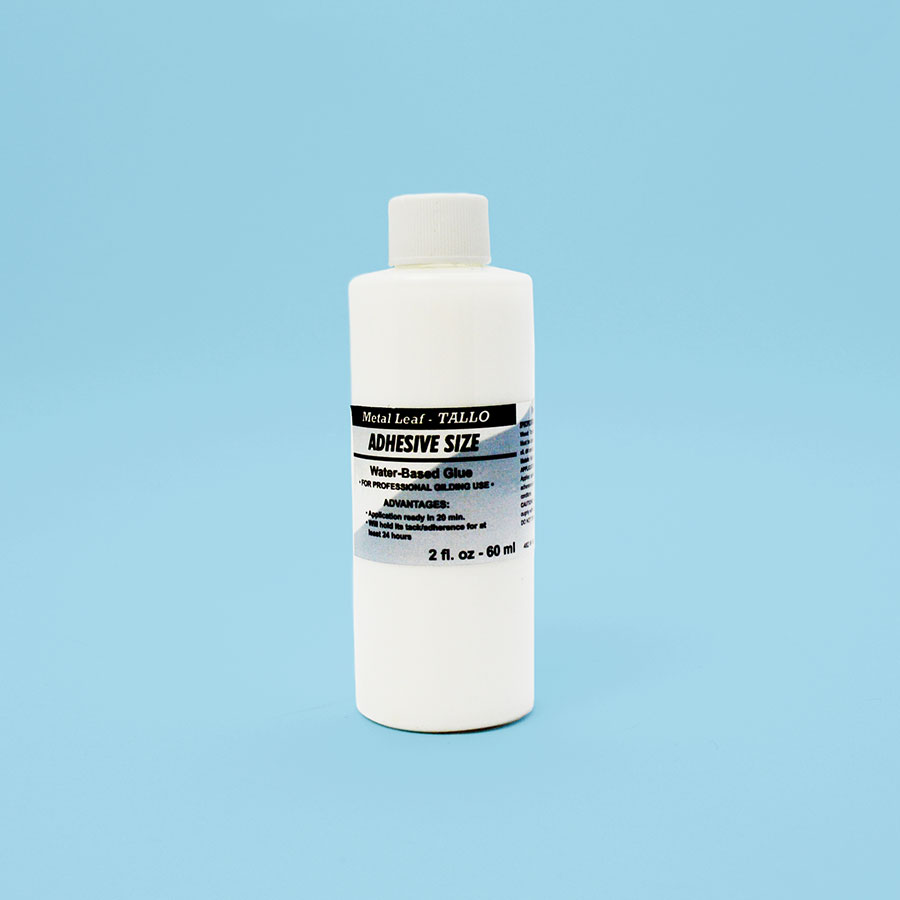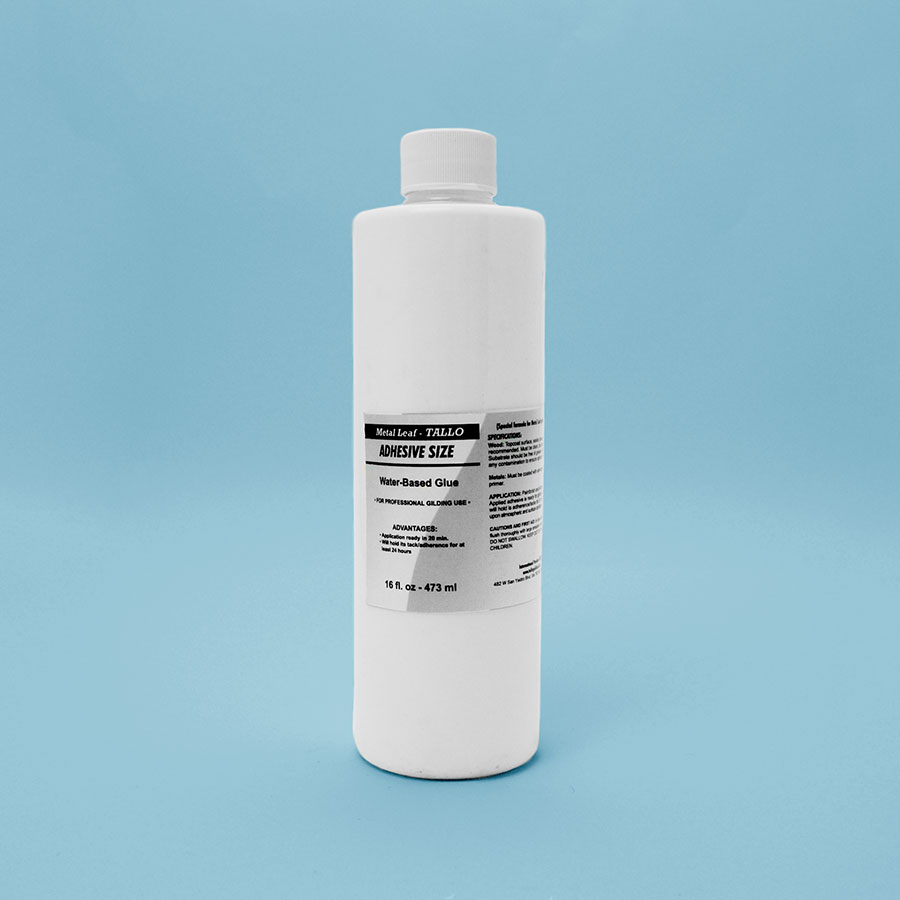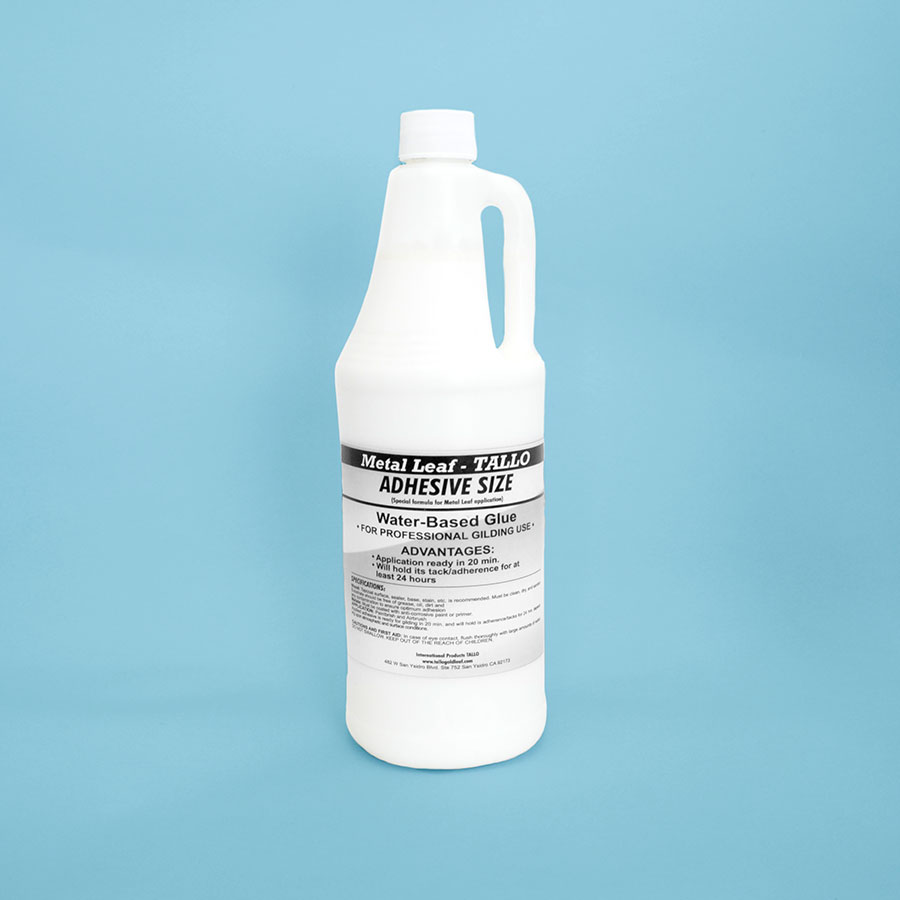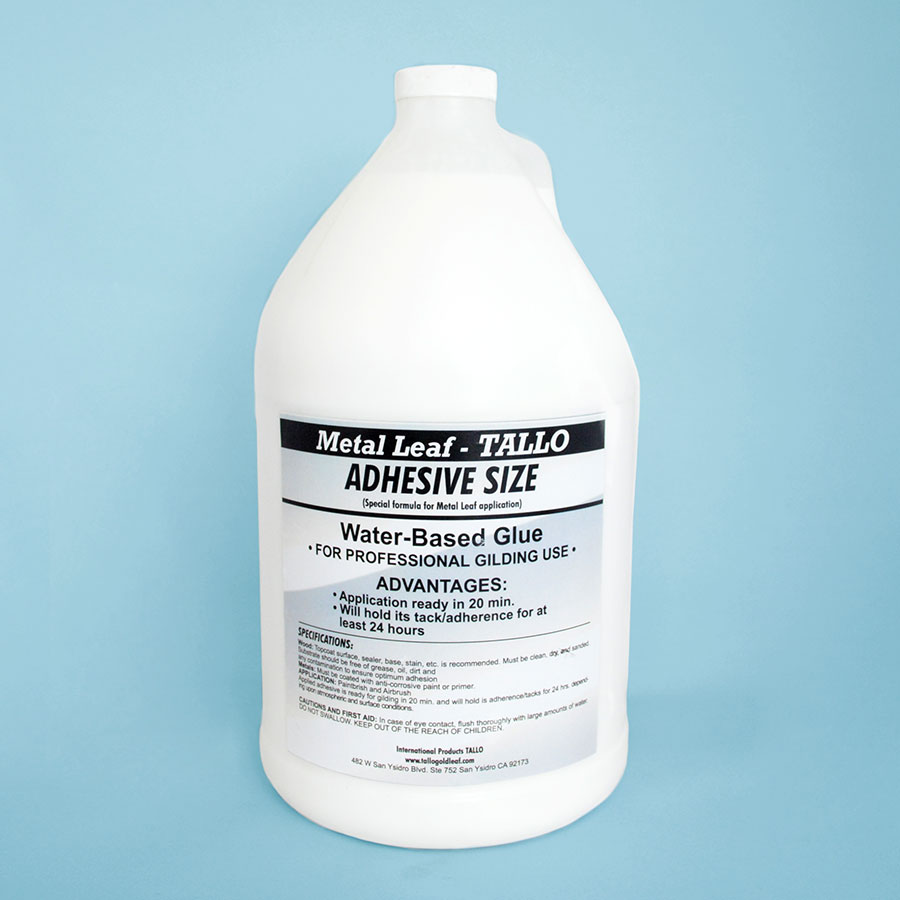Description
Approximate coverage areas of our packaged imitation leaf
You can use Adhesive Size (Water Based) for Gilding according to the coverage area needed for your gold leaf or silver leaf project. Use the following table for reference:
| Item code | Fluid Ounce | Square Feet Covers | Fluid Liters | Square Meter Covers | Price |
|---|---|---|---|---|---|
| AD-02 | 2 oz | 6ft² | 60 mL | 0.5 m² | $3.75 |
| AD-04 | 4 oz | 12ft² | 120 mL | 1 m² | $6 |
| AD-16 | 16 oz | 52ft² | 473 mL | 5 m² | $14 |
| AD-32 | 32 oz | 105 ft² | 946 mL | 10 m² | $20 |
| AD-64 | 64 oz | 210 ft² | 1,892 mL | 20 m² | $30 |
| AD-128 | 128 oz | 420 ft² | 1 Gallons (3.78 L) | 40 m² | $45 |
Water Adhesive Size vs Walter Gilding
Tallo Adhesive Size (Water Based) for gilding is a relatively new contemporary formula to the craft of gilding is synthetic water-based size. This adhesive size work exactly like oil adhesive size, in that it is applied to a prepared surface and must become tacky before the leaf is laid. Understandably, this often causes some confusion in terms; Tallo water base adhesive size is not Water Gilding.
Tallo Adhesive Size is much simpler. Its ease use makes it a natural choice for contemporary applications. It gets its name from the oil-based size “sometime referred to as resin size” that is used in the manufacturing process. Water Gilding is antique formula can be made from Rabbit skin, Gelatin and Animal glue (dissolved in water). Glues from animal was the most common glue for thousands of years until the advent of synthetic glues such as polyvinyl acetate (PVA) and other resin glues in the 20th century. Today it is used primarily in specialty applications such as antique restoration.
- Rabbit skin glue is an animal glue created by prolonged boiling of animal connective tissue.
- Gelatin is extracted from the skin, bones, and connective tissues of animals.
- Animal glue is formed of the collagen from skins, bones, tendons, and other tissues, similar to gelatin.
How to prepare Rabbit Skin or How to prepare Animal glue
Preparation:
To prepare hide glue for use, you have to soak the pellets in cold water for several hours until they soften and become gelatinous. If you’ve never used hide glue before, it’s best to start with a small batch. Put three tablespoons of dry glue in a heat-resistant glass container (most food jars work well) and cover with two tablespoons of water. A larger batch of glue can be made using the same proportion of glue to water.
Next, place the gelatinous glue mixture into a water bath. Heat the water to 140°F. Be sure to use a thermometer, as it’s important to maintain this temperature. If the water gets too hot, it will overheat the glue and cause it to lose strength. It’s a good idea to stir the glue mixture occasionally to help work out any lumps but it’s not absolutely necessary.
After a few minutes, the pellets will be melted and the glue will be ready to use. A properly prepared and heated batch of glue forms a steady thread as it drips from a brush back into the glue pot. If the glue drips from the brush in droplets, it’s too thin. To thicken it, stir the glue while it’s being heated until sufficient water has evaporated from the mixture. If the glue forms thick clumps on the brush, dilute it with hot water until the desired consistency is achieved.
How to apply adhesive size for gilding
Tools:
- Nitrile or Latex Gloves
- Cotton Wool
- Paint-brush or camel hair brush
Choice of small objects for the first trials, the best begins with inexpensive frames ornaments or with sample board wood.
Surface Application
Gilder´s tip A: for the adhesive to slide smoothly on the surface and get thinnest film: dilute adhesive size with water in a bowl (from 90% to 80% adhesive-size- to 10%-20% water)
- Application of adhesive-size to a surface is more readily accomplished with a cotton wool, paint brush or camel-hair brush of suitable proportions.
- The object is to cover the surface with the thinnest possible film, avoid adhesive size excess, drops, bubbles and squirt. A brush is essential for carvings in order to reach deep into the interstices, molding or applied design.
This tip B is optional: help to get a “thin film surface“ and “removes adhesive size excess, drops, bubbles and squirt”, for creates a better finished product
Dilute adhesive size with water in a bowl (from 70% adhesive-size- to 30% water)
Used a cotton cloth or cotton wool, wet a cloth and squeeze.
- You will need , wet a cloth and squeeze it, then remove the first layer of adhesive size, wet a cloth and squeeze it, then remove the first layer of adhesive size, gently and one way directions in order to get super thin film surface, Wet and squeeze the cloth as often as necessary.
- After the surface has been covered wait for it to become tacky, or reaches tack 30 minutes before applying the leaf. it will remain tacky for several hours before it dries completely and loses tack.
- Experienced gilders advise that applying the leaf 4 hours after or went the tallo adhesive size has almost lost its tack gives the best result. They also believe the adhesive size that takes the longest to reach tack creates a better finished product
- Tallo water adhesive size become tacky in 30 minutes and remains tacky for 30 hours. Weather can affect the time it takes for any adhesive size to become tacky, so take into account humid and dry condition.
How to calculate the area of a surface of furniture?
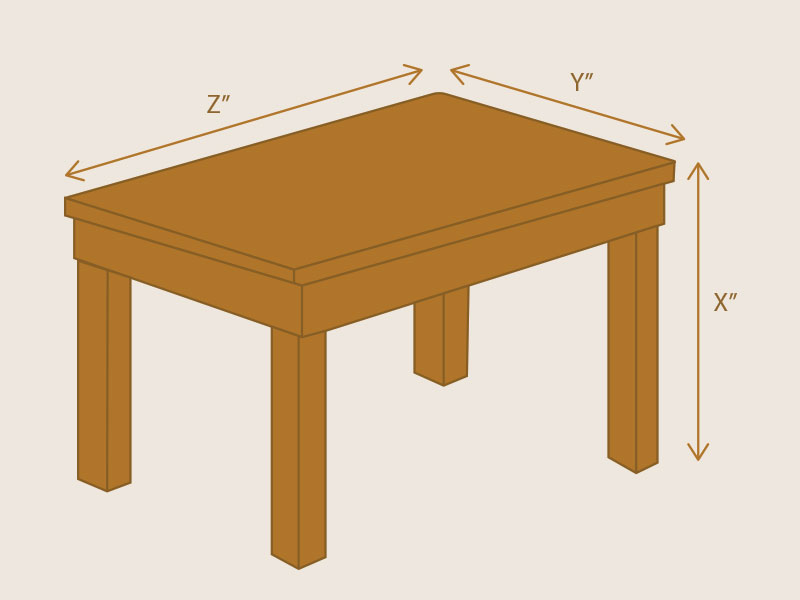

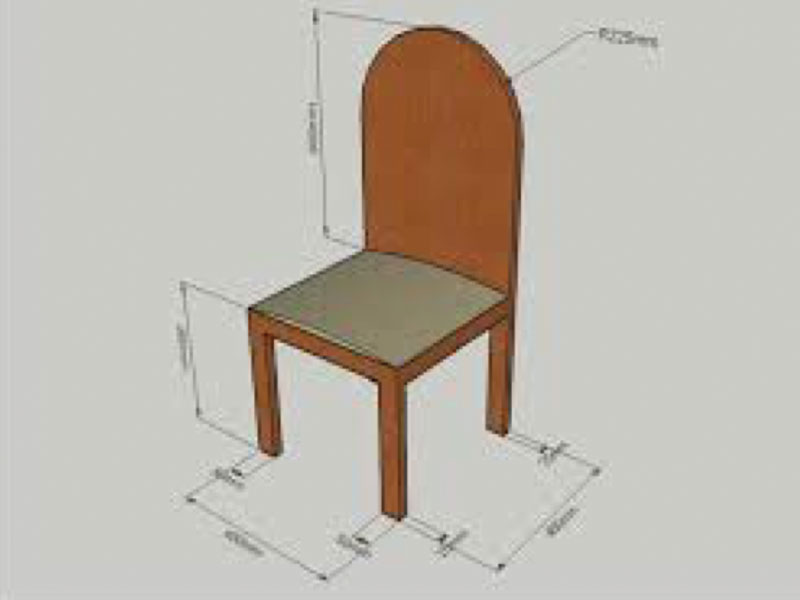

 and major credit cards
and major credit cards
